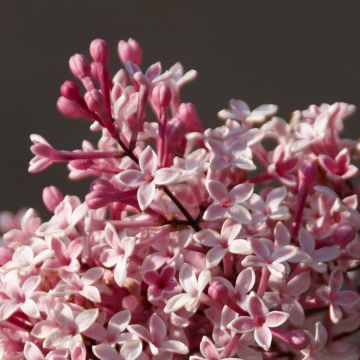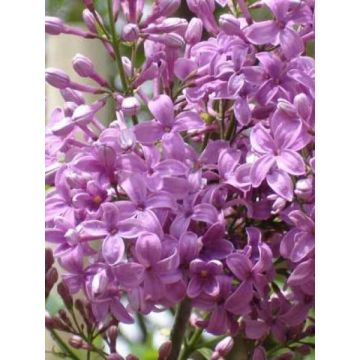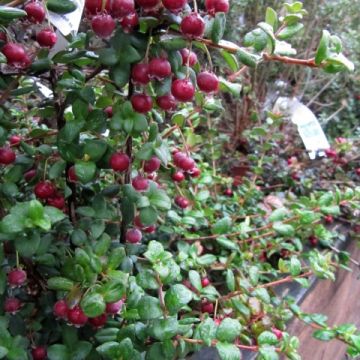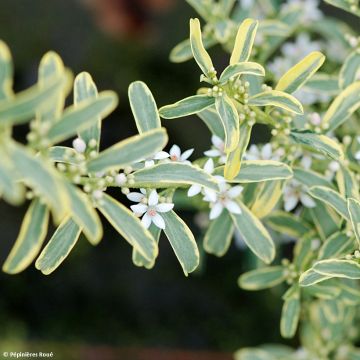

Syringa patula Dream Cloud - Korean Lilac
Syringa patula Dream Cloud - Korean Lilac
Syringa patula Dream Cloud™ ('KLMone')
Miss Kim Lilac, Korean Lilac.
Why not try an alternative variety in stock?
View all →This plant carries a 24 months recovery warranty
More information
We guarantee the quality of our plants for a full growing cycle, and will replace at our expense any plant that fails to recover under normal climatic and planting conditions.
From €5.90 for pickup delivery and €6.90 for home delivery
Express home delivery from €8.90.
Does this plant fit my garden?
Set up your Plantfit profile →
Description
Chinese Lilac or Syringa patula Dream Cloud™, known by its cultivar name 'KLMone' is a variety with a spectacular flowering, so abundant that it almost entirely covers the foliage. This variety forms a modest-sized bush, covered in early summer with large panicles of fluffy lavender-pink flowers, which can measure 35 cm long and 25 cm wide, with an intoxicating fragrance. In autumn, the foliage turns red to purple as temperatures cool down. More resistant to powdery mildew than other lilacs, it simply requires an annual pruning just after flowering. Plant it along a sunny garden path or on a terrace.
Syringa patula belongs to the Oleaceae family. It is endemic to Korea and northeastern China unlike the common Lilac native to Europe. This new species has been found in humid mountain areas, at high altitudes and in vast spaces. Dream Cloud forms at maturity a compact and bushy bush of about 1.20 to 1.50 m in height and spread. Its almost horizontal branches bear deciduous, glossy, light green leaves. In late spring, large panicles of pale lilac pink flowers bloom. The flowers are smaller and finer than on traditional Lilacs, but more numerous and equally fragrant. It's almost impossible to resist the temptation to make a beautiful fragrant bouquet for the home.
Syringa patula Dream Cloud is a very easy to grow bush. It thrives in the sun, in moist and light soils, but also tolerates partial shade and heavy, rich clay soils. Its compact habit makes it interesting in small gardens and for those who have experienced a common lilac with exuberant growth and a bit too bulky. It finds a place in gardens of all sizes near the house to enjoy its fragrance or in groups and can also bloom on terraces, with regular watering. It can also be planted in a small informal hedge, in association with other species like flowering crabapples, Japanese cherries, Chinese almonds, Japanese quinces or deutzias. Its fragrant clusters of flowers are ideal for creating beautiful bouquets.
```Report an error about the product description
Plant habit
Flowering
Foliage
Botanical data
Syringa
patula
Dream Cloud™ ('KLMone')
Oleaceae
Miss Kim Lilac, Korean Lilac.
Cultivar or hybrid
Other Syringa - Lilac
Planting and care
The Syringa patula Dream Cloud appreciates planting in full sun, in a soil that remains fairly moist and well-drained. It can tolerate any type of soil. It will grow well in a partially shaded position, but flowering will be reduced. Easy to grow, it requires only mulching in the summer in dry climates to maintain some moisture. Water it in the first years in case of marked drought. You can prune the flowering branches to make beautiful bouquets, or at the end of flowering to promote the appearance of new flowers and avoid tiring the bush. Avoid severe pruning that limits the flowering of the following spring, unless your Syringa is becoming too large.
Planting period
Intended location
Care
This item has not been reviewed yet - be the first to leave a review about it.
Hedge shrubs
Haven't found what you were looking for?
Hardiness is the lowest winter temperature a plant can endure without suffering serious damage or even dying. However, hardiness is affected by location (a sheltered area, such as a patio), protection (winter cover) and soil type (hardiness is improved by well-drained soil).

Photo Sharing Terms & Conditions
In order to encourage gardeners to interact and share their experiences, Promesse de fleurs offers various media enabling content to be uploaded onto its Site - in particular via the ‘Photo sharing’ module.
The User agrees to refrain from:
- Posting any content that is illegal, prejudicial, insulting, racist, inciteful to hatred, revisionist, contrary to public decency, that infringes on privacy or on the privacy rights of third parties, in particular the publicity rights of persons and goods, intellectual property rights, or the right to privacy.
- Submitting content on behalf of a third party;
- Impersonate the identity of a third party and/or publish any personal information about a third party;
In general, the User undertakes to refrain from any unethical behaviour.
All Content (in particular text, comments, files, images, photos, videos, creative works, etc.), which may be subject to property or intellectual property rights, image or other private rights, shall remain the property of the User, subject to the limited rights granted by the terms of the licence granted by Promesse de fleurs as stated below. Users are at liberty to publish or not to publish such Content on the Site, notably via the ‘Photo Sharing’ facility, and accept that this Content shall be made public and freely accessible, notably on the Internet.
Users further acknowledge, undertake to have ,and guarantee that they hold all necessary rights and permissions to publish such material on the Site, in particular with regard to the legislation in force pertaining to any privacy, property, intellectual property, image, or contractual rights, or rights of any other nature. By publishing such Content on the Site, Users acknowledge accepting full liability as publishers of the Content within the meaning of the law, and grant Promesse de fleurs, free of charge, an inclusive, worldwide licence for the said Content for the entire duration of its publication, including all reproduction, representation, up/downloading, displaying, performing, transmission, and storage rights.
Users also grant permission for their name to be linked to the Content and accept that this link may not always be made available.
By engaging in posting material, Users consent to their Content becoming automatically accessible on the Internet, in particular on other sites and/or blogs and/or web pages of the Promesse de fleurs site, including in particular social pages and the Promesse de fleurs catalogue.
Users may secure the removal of entrusted content free of charge by issuing a simple request via our contact form.
The flowering period indicated on our website applies to countries and regions located in USDA zone 8 (France, the United Kingdom, Ireland, the Netherlands, etc.)
It will vary according to where you live:
- In zones 9 to 10 (Italy, Spain, Greece, etc.), flowering will occur about 2 to 4 weeks earlier.
- In zones 6 to 7 (Germany, Poland, Slovenia, and lower mountainous regions), flowering will be delayed by 2 to 3 weeks.
- In zone 5 (Central Europe, Scandinavia), blooming will be delayed by 3 to 5 weeks.
In temperate climates, pruning of spring-flowering shrubs (forsythia, spireas, etc.) should be done just after flowering.
Pruning of summer-flowering shrubs (Indian Lilac, Perovskia, etc.) can be done in winter or spring.
In cold regions as well as with frost-sensitive plants, avoid pruning too early when severe frosts may still occur.
The planting period indicated on our website applies to countries and regions located in USDA zone 8 (France, United Kingdom, Ireland, Netherlands).
It will vary according to where you live:
- In Mediterranean zones (Marseille, Madrid, Milan, etc.), autumn and winter are the best planting periods.
- In continental zones (Strasbourg, Munich, Vienna, etc.), delay planting by 2 to 3 weeks in spring and bring it forward by 2 to 4 weeks in autumn.
- In mountainous regions (the Alps, Pyrenees, Carpathians, etc.), it is best to plant in late spring (May-June) or late summer (August-September).
The harvesting period indicated on our website applies to countries and regions in USDA zone 8 (France, England, Ireland, the Netherlands).
In colder areas (Scandinavia, Poland, Austria...) fruit and vegetable harvests are likely to be delayed by 3-4 weeks.
In warmer areas (Italy, Spain, Greece, etc.), harvesting will probably take place earlier, depending on weather conditions.
The sowing periods indicated on our website apply to countries and regions within USDA Zone 8 (France, UK, Ireland, Netherlands).
In colder areas (Scandinavia, Poland, Austria...), delay any outdoor sowing by 3-4 weeks, or sow under glass.
In warmer climes (Italy, Spain, Greece, etc.), bring outdoor sowing forward by a few weeks.


































































